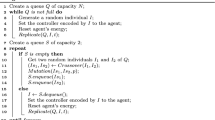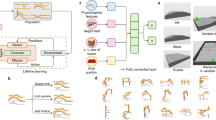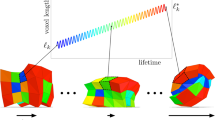Abstract
This paper investigates the processes used by an evolved, embodied simulated agent to adapt to large disruptive changes in its sensor morphology, whilst maintaining performance in a phototaxis task. By avoiding the imposition of separate mechanisms for the fast sensorimotor dynamics and the relatively slow adaptive processes, we are able to comment on the forms of adaptivity which emerge within our Evolutionary Robotics framework. This brings about interesting notions regarding the relationship between different timescales. We examine the dynamics of the network and find different reactive behaviours depending on the agent’s current sensor configuration, but are only able to begin to explain the dynamics of the transitions between these states with reference to variables which exist in the agent’s environment, as well as within its neural network ‘brain’.
Preview
Unable to display preview. Download preview PDF.
Similar content being viewed by others
References
Beer, R.D.: On the dynamics of small continuous-time recurrent neural networks. Adaptive Behavior 3(4), 471–511 (1995)
Bi, G.Q., Poo, M.M.: Synaptic modifications in cultured hippocampal neurons: dependence on spike timing, synaptic strength, and postsynaptic cell type. Journal of Neuroscience 18, 10464–10472 (1998)
Bongard, J., Zykov, V., Lipson, H.: Resilient Machines Through Continuous Self-Modeling. Science 314(5802), 1118–1121 (2006)
Di Paolo, E.A.: Homeostatic adaptation to inversion of the visual field and other sensorimotor disruptions. In: Meyer, J.-A., et al. (eds.) Proc. of the Sixth Int. Conf. on the Simulation of Adaptive Behavior, pp. 440–449. MIT Press, Cambridge (2000)
Floreano, D., Urzelai, J.: Neural Morphogenesis, Synaptic Plasticity, and Evolution. Theory in Biosciences 120(3-4), 225–240 (2001)
Hölscher, C.: Nitric Oxide, the Enigmatic Neuronal Messener: its Role in Synaptic Plasticity. Trends in Neuronscience 20, 298–303 (1997)
Izquierdo-Torres, E., Harvey, I.: Learning on a Continuum in Evolved Dynamical Node Networks. In: Rocha, L., et al. (eds.) Proc. of the Tenth Int. Conf. on the Simulation and Synthesis of Living Systems, pp. 507–512. MIT Press, Cambridge (2006)
O’Regan, J.K., Noë, A.: A sensorimotor account of vision and visual consciousness. Behavioral and Brain Sciences 24(5), 939–1011 (2001)
Phattanasri, P., Chiel, H.J., Beer, R.D.: The dynamics of associative learning in evolved model circuits. Submitted to Adaptive Behavior.
Philipona, D., O’Regan, J.K., Nadal, J.P., Coenen, O.J.-M.D.: Perception of the structure of the physical world using unknown sensors and effectors. Advances in Neural Information Processing Systems 15 (2004)
Tuci, E., Quinn, M., Harvey, I.: An evolutionary ecological approach to the study of learning behaviour using a robot based model. Adaptive Behavior 10(3), 201–221 (2003)
Yamauchi, B., Beer, R.D.: Integrating reactive, sequential and learning behavior using dynamical neural networks. In: Cliff, D., et al. (eds.) Proc. of the Third Int. Conf. on Simulation of Adaptive Behavior, pp. 382–391. MIT Press, Cambridge (1994)
Author information
Authors and Affiliations
Editor information
Rights and permissions
Copyright information
© 2007 Springer-Verlag Berlin Heidelberg
About this paper
Cite this paper
Fine, P., Di Paolo, E., Izquierdo, E. (2007). Adapting to Your Body. In: Almeida e Costa, F., Rocha, L.M., Costa, E., Harvey, I., Coutinho, A. (eds) Advances in Artificial Life. ECAL 2007. Lecture Notes in Computer Science(), vol 4648. Springer, Berlin, Heidelberg. https://doi.org/10.1007/978-3-540-74913-4_21
Download citation
DOI: https://doi.org/10.1007/978-3-540-74913-4_21
Publisher Name: Springer, Berlin, Heidelberg
Print ISBN: 978-3-540-74912-7
Online ISBN: 978-3-540-74913-4
eBook Packages: Computer ScienceComputer Science (R0)




